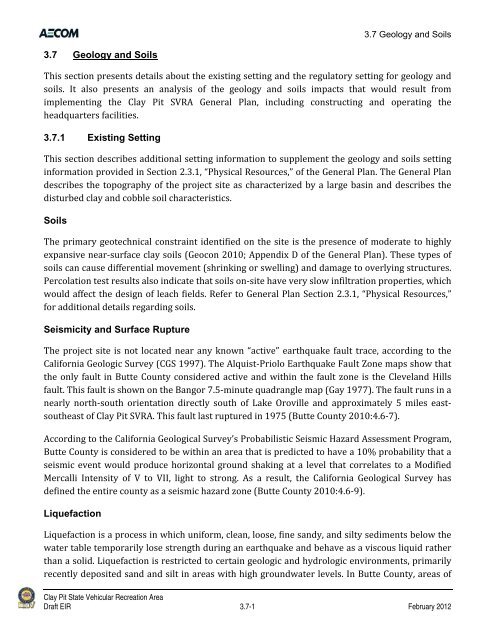Draft Environmental Impact Report - California Off Highway Vehicle ...
Draft Environmental Impact Report - California Off Highway Vehicle ...
Draft Environmental Impact Report - California Off Highway Vehicle ...
You also want an ePaper? Increase the reach of your titles
YUMPU automatically turns print PDFs into web optimized ePapers that Google loves.
3.7 Geology and Soils<br />
3.7 Geology and Soils<br />
This section presents details about the existing setting and the regulatory setting for geology and<br />
soils. It also presents an analysis of the geology and soils impacts that would result from<br />
implementing the Clay Pit SVRA General Plan, including constructing and operating the<br />
headquarters facilities.<br />
3.7.1 Existing Setting<br />
This section describes additional setting information to supplement the geology and soils setting<br />
information provided in Section 2.3.1, “Physical Resources,” of the General Plan. The General Plan<br />
describes the topography of the project site as characterized by a large basin and describes the<br />
disturbed clay and cobble soil characteristics.<br />
Soils<br />
The primary geotechnical constraint identified on the site is the presence of moderate to highly<br />
expansive near‐surface clay soils (Geocon 2010; Appendix D of the General Plan). These types of<br />
soils can cause differential movement (shrinking or swelling) and damage to overlying structures.<br />
Percolation test results also indicate that soils on‐site have very slow infiltration properties, which<br />
would affect the design of leach fields. Refer to General Plan Section 2.3.1, “Physical Resources,”<br />
for additional details regarding soils.<br />
Seismicity and Surface Rupture<br />
The project site is not located near any known “active” earthquake fault trace, according to the<br />
<strong>California</strong> Geologic Survey (CGS 1997). The Alquist‐Priolo Earthquake Fault Zone maps show that<br />
the only fault in Butte County considered active and within the fault zone is the Cleveland Hills<br />
fault. This fault is shown on the Bangor 7.5‐minute quadrangle map (Gay 1977). The fault runs in a<br />
nearly north‐south orientation directly south of Lake Oroville and approximately 5 miles east‐<br />
southeast of Clay Pit SVRA. This fault last ruptured in 1975 (Butte County 2010:4.6‐7).<br />
According to the <strong>California</strong> Geological Survey’s Probabilistic Seismic Hazard Assessment Program,<br />
Butte County is considered to be within an area that is predicted to have a 10% probability that a<br />
seismic event would produce horizontal ground shaking at a level that correlates to a Modified<br />
Mercalli Intensity of V to VII, light to strong. As a result, the <strong>California</strong> Geological Survey has<br />
defined the entire county as a seismic hazard zone (Butte County 2010:4.6‐9).<br />
Liquefaction<br />
Liquefaction is a process in which uniform, clean, loose, fine sandy, and silty sediments below the<br />
water table temporarily lose strength during an earthquake and behave as a viscous liquid rather<br />
than a solid. Liquefaction is restricted to certain geologic and hydrologic environments, primarily<br />
recently deposited sand and silt in areas with high groundwater levels. In Butte County, areas of<br />
Clay Pit State Vehicular Recreation Area<br />
<strong>Draft</strong> EIR 3.7-1 February 2012








